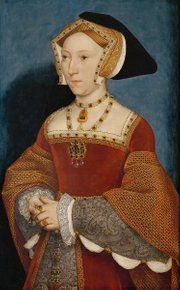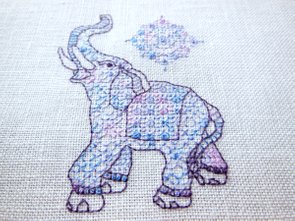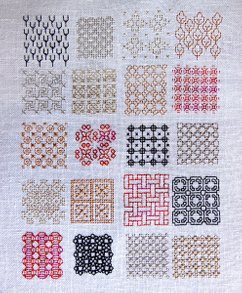Blackwork Practice
Click on the images to enlarge them!
December 2020 - March 2021
Is Blackwork Black?
Not necessarily.
What we are familiar with as blackwork today, was originally known as Spanish work. It was Catalina de Aragón y Castilla, better known to us as Catherine of Aragon, who reputedly brought many garments embroidered in this way with her when she came to England after her marriage with Arthur, Prince of Wales, from the House of Tudor in 1501.
Spanish work was inspired by the Moorish tradition of white linen embroidered in black wool or silk, sometimes enriched with metal threads. Due to the Aniconism in Islam, the motifs were mainly symmetrically arranged geometric figures. In 1509, Catherine married Henry VIII, and for more than 20 years this kind of embroidery remained all the rage at the English court.
It was then used mostly on the edges of shirts, on collars and cuffs, which were embroidered with black geometric designs. The malicious gossip has it that this had also the handy side-effect of disguising dirt during a time of poor hygiene, to which Jonathan Swift's poem The Lady's Dressing Room bears eloquent witness. (Don't read it if you get disgusted quickly!)
It was often a reversible embroidery, which could be achieved by using double-running stitch, or Holbein stitch, named after Henry VIII’s court painter Hans Holbein the Younger, because many of his royal portraits displayed it.
Hans Holbein the Younger. Portrait of Jane Seymour. 1537.
Source: Wikipedia
Later on, at the dawn of the Renaissance era, flowing designs, such as flowers or mythical beasts, filled with the known geometrical patterns, began to dominate.
In any case, the embroidery of repeating patterns on white fabric with a contrasting thread is much older than Spanish work. It has its roots in many countries and cultures. Types of counted thread embroidery in black are found in many countries, such as Russia or the Balkan countries. What Catherine of Aragon did was to introduce this style and make it fashionable for the upper classes in England, but as a verse from the Canterbury Tales by Geoffrey Chaucer (ca. 1400) shows, blackwork was present in England long before her arrival there.
However, as we can see from many paintings from that era, the fashion of wearing blackwork was not limited to England, but was obviously popular throughout Europe.
What is Blackwork, Then?
Regarding the technical side, blackwork is a counted thread embroidery, today done mostly on evenweave, historically on plain weave with a very high thread count. It is a closely textured stitching, using mostly double runnig (Holbein) stitch, backstitch, and stem stitch.
In the past, it was mostly worked in black, though occasionally also in colour, as can be seen on a band sampler from the early 1600s.
According to Wikipedia, blackwork has three common styles: counted stitches in geometric or small floral patterns; large flowing designs of fruits, flowers etc. (not counted); an illustrative style with outlined patterns, shaded with seed stitches.
Today blackwork can be found in two main styles, the widest known of which consists of repeating geometrical patterns, outlined in backstitch. What seems to be somewhat less widely known is the modern shaded blackwork. After a long period of demise of this technique, it was in the 1960s that embroiderers associated with the Embroiderers' Guild began to experiment in this direction, and the style was further developed by the Royal School of Needlework.
The shading is achieved in three ways: by using different thicknesses of thread; a different density of the patterns (size, omitted stitches); or by colour shading. Today blackwork is often worked in various colours as well. An intricate shading allows for creating of impressive pictures instead of being used for adornment only.
The Beginning of a Fascinating Journey
For obvious reasons, I'm an avid collector of free downloads of embroidery books and textes. So it happened that I had already gathered a whole series of blackwork files in pdf format in my literature folder called Ensamplario Atlantio. Being a Collection of Filling Patterns Suitable for Blackwork Embroidery. Janthé d'Aberoigne. The author is Kim Brody Salazar who offers these files for free download on her website String-or-Nothing.
So I sat down and tried some of her patterns myself.
My First Blackwork Patterns
If you want to learn how to work a completely two-sided double running stitch (which isn't easy at all!), then visit Kim's very helpful series of tutorials on the Double Running Stitch Logic on her website!
Double Running Stitch Logic
To be able to do that, you need a continuous pattern without detached elements, as in the patterns 1, 2, 5, 6 and 8 in the photo above. (In pattern #1, I experimented with my newly acquired textile watercolours.)
Now I was eager to stitch a little picture in blackwork. Russian Blackwork offers a couple of free blackwork patterns, and I fell in love with the little elephant. It was around the turn of the year. I was ill, and stitching quietly this cute little elephant was exactly what I needed right now.
Blackwork Elephant, Variegated
Moving on
Yet I had something else in mind. It had been my wish from the beginning to embroider pictures, after all, not mere patterns. What I had in mind was an impressive blackwork done by Grace Lister depicting Tunbridge Wells. Isn't it gorgeous? How could I achieve something similar?
It seemed that I couldn't avoid to buy some books on blackwork. It was the beginning of December, and luckily, my birthday was coming up. Unluckily, it turned out that the best of the recommended books are all out of print, including the RSN Essential Stitch Guide for Blackwork. Some can still be bought somewhere, but of course at prohibitive prices.
Eventually, I found some older books, and I put them on my birthday wish list: Elisabeth Geddes & Moyra McNeill Blackwork Embroidery plus Lesley Wilkins Beginner's Guide to Blackwork.
Geddes' & McNeill's book contains an extensive part on blackwork history, which is a good thing. The practical part, on the other hand, turned out not to be practical for me at all. There is a lot of experimenting, but in the style of the 1960s, when the book was published, which isn't my cup of tea at all.
Wilkins' Beginner's Guide is nice - but it is still about geometric patterns, no shading techniques included. I decided to work a panel of fill-in patterns for practice anyway, and to experiment with shading on my own later on.
Blackwork Fill-in Patterns by Lesley Wilkins
Then I remembered a blackwork portrait of an angel done by Maria del Valle. Hell, yeah! If Grace Lister's Tunbridge Wells was gorgeous, then this portrait is breath-taking! It is exactly what I want to achieve, but studying the photo once more, my confusion was complete. I just didn't have an idea where and how to start.
Maybe it was this angel who sent me the inspiration in mid-February to stop by the website of the Royal School of Needlework ...
My heart skipped a beat when I discovered that the RSN offers a whole range of self-paced online video courses, including an Introduction to Blackwork - all for an affordable price even for my purse!!! And the blackwork course covers shading!
Now please follow me to my Blackwork "Sampler" (read: picture): a puffin from the video course by Helen McCook from the RSN. Actually two puffins ...
References:
Helen McCook. Introduction to Blackwork Embroidery. Self-paced Online Video Course. Royal School of Needlework
Jen Goodwin. Blackwork Embroidery. Techniques and Projects. The Crowded Press Ltd. Ramsbury, Marlborough. 2020
Blackwork. Wikipedia




